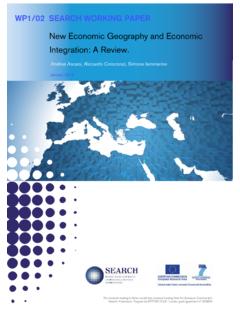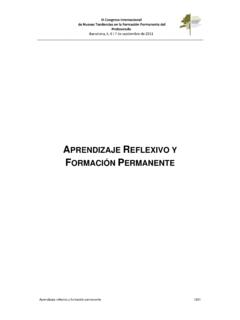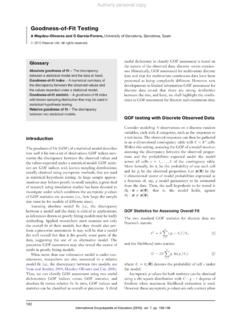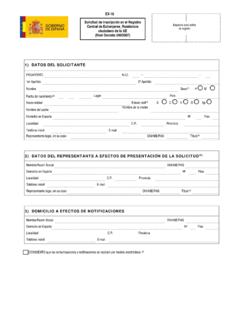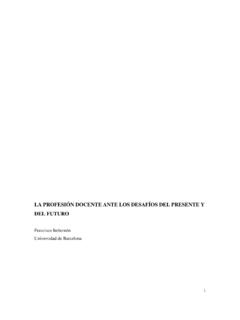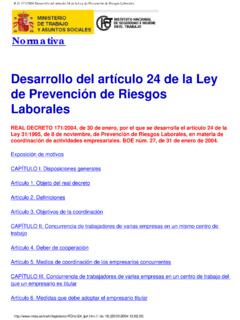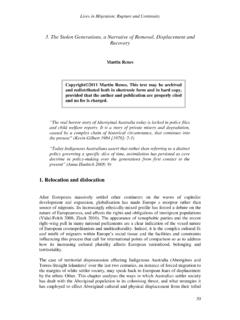Transcription of 2. The British Invasion of Australia. Convicts: Exile and ...
1 Lives in Migration: Rupture and Continuity 16 2. The British Invasion of australia . Convicts: Exile and Dislocation Sue Ballyn On January the 26th 1788 eleven British ships under the command of Captain Arthur Phillip, first Governor of the new colony, anchored on the east coast of australia at Sydney Cove and raised the British Known as the First Fleet the ships sailed from England on the 13th of May 1787. All told, the First Fleet carried 1,500 people comprised of convicts, crew and guards. As Bateson points out: The returns of the prisoners are contradictory, but the best evidence indicates that the six convict ships sailed with 568 male and 191 female prisoners a total of 759 convicts (.)
2 (Bateson 1985: 97). The route followed by the First Fleet can be seen on the map below:ii Following the direction of the prevailing trade winds and ocean currents, the route took the First Fleet from England to the Canary Islands, then southwards across the Atlantic to Rio de Janeiro to take on supplies,iii then south-eastward following the westerly winds across the Atlantic to the Cape and finally from there across the Indian and Southern Oceans to their final Robert Hughes gives a good idea of how many of those on board must have felt as they departed from the Cape: Before them stretched the awesome, lonely void of the Indian and Southern Oceans, and beyond that lay nothing they could imagine (1987: 82).
3 While at the Cape, the Fleet had become something of a Noah s Ark, taking on board livestock to sustain the new colony, seeds and plants. If, as they left the Cape, ahead lay nothing they could imagine , similarly they knew nothing about what the soil in the new colony would sustain, the climate, Copyright 2011 Sue Ballyn. This text may be archived and redistributed both in electronic form and in hard copy, provided that the author and publication are properly cited and no fee is charged. Lives in Migration: Rupture and Continuity 17 rainfall averages, nor even how exactly the indigenous peoples might react to their presence.
4 It would be fair to say that sending the First Fleet out to New South Wales was a calculated risk; that the colony survived and progressed is due almost entirely to the arrival of the Second Fleet in June 1790. The arrival of these ships saved the colony from starvation and certain death. From then onwards, as ships came out on a regular basis with convict labour and supplies on board, the colony flourished and the gradual exploration and settlement of the continent The reasons that led the British to invade australia were simple. The prisons in Britain had become unbearably overcrowded, a situation worsened by the refusal of America to take any more convicts after the American War of Independence in 1783.
5 Crime rates were rising across the nation while large numbers of people were moving away from rural areas to the increasingly industrialised cities where unemployment ran high as machines replaced man power. An estimated one million people in Britain were below the bread line in 1788. Britain had looked at other geographical areas with regard to establishing penal colonies such as the west coast of Africa. This option was deemed unviable as the waters were extremely dangerous along the coast; Britain had no proper foothold in the area and it was concluded that the risk of escape was high.
6 Early contact had revealed that the indigenous populations on the coast of West Africa could indeed be bellicose. This was not a good scenario for a penal colony! On the other hand, the Indigenous Peoples of australia had barely been seen, and descriptions of those that had were deemed to be of a more friendly nature. There has long been a debate, known to some as The Botany Bay Debate , that australia was also chosen by the British with regard to the possibility of acquiring flax and timber, because of the need to protect the trade routes to China, and in order to consolidate Cook s possession of the continent for Britain.
7 Whatever the debate, there is no doubt that the need to relocate the burgeoning convict population was the reason which prevailed over others. The British had long been experts in transporting human cargo. Transportation of felons to America had begun in the seventeenth century and although the total number of those transported is not known, it is estimated to be in the region of fifty thousand. Similarly Britain had played a large lucrative role in the slave trade, abolished in 1807, though slavery itself remained legal until the Slavery Abolition Act of 1833. It seems ironic that while abolishing the slave trade and slavery, the British continued to transport convicts to australia for some time after 1833.
8 Convicts were of course judicially not slaves and transportation continued until the 1850s. The reason why transportation finally came to an end was due in part to activism in England against it and the government s and colonial authorities belief that the continued arrival of convicts would have a long-lasting detrimental effect on the new colonial society. A further side to transportation of convicts by the British is that of inter-colonial transportation such as that to the Andaman Islands, which began as a result of the Indian rebellion in 1857. A study of inter-colonial transportation within the British Empire reveals that the practice of transporting felons, dissidents and so forth to other places in the empire was widely practiced.
9 The Invasion of australia by the British , both convict and free, has tragic dimensions to it pertinent to the title of this book. On the one hand there were the convicts who were Lives in Migration: Rupture and Continuity 18 forcibly removed, uprooted and exiled from their homeland and, on the other, their presence in australia , together with that of the free migrants, brought about the displacement of the Indigenous peoples of australia . Worse than that, in time the Indigenous peoples were to find themselves exiled from their homeland and embroiled in a cultural dislocation, brought about by British and colonial intervention against their peoples, the evidence of which remains only too strongly with us today.
10 Genocide went hand in hand with the policy of eugenics which in turn led to the forced removal of half-caste children from their families, bringing about an Exile upon Exile . Indigenous peoples were exiled from their lands and taken into missions and then their children, often the product of rape, though also of long/short standing relationships with the white man, were dragged away from their mothers and taken thousands of miles away to be educated , thereby becoming doubly exiled from their familial roots. The stories that emerge from what has become known as The Stolen Generation are harrowing.
